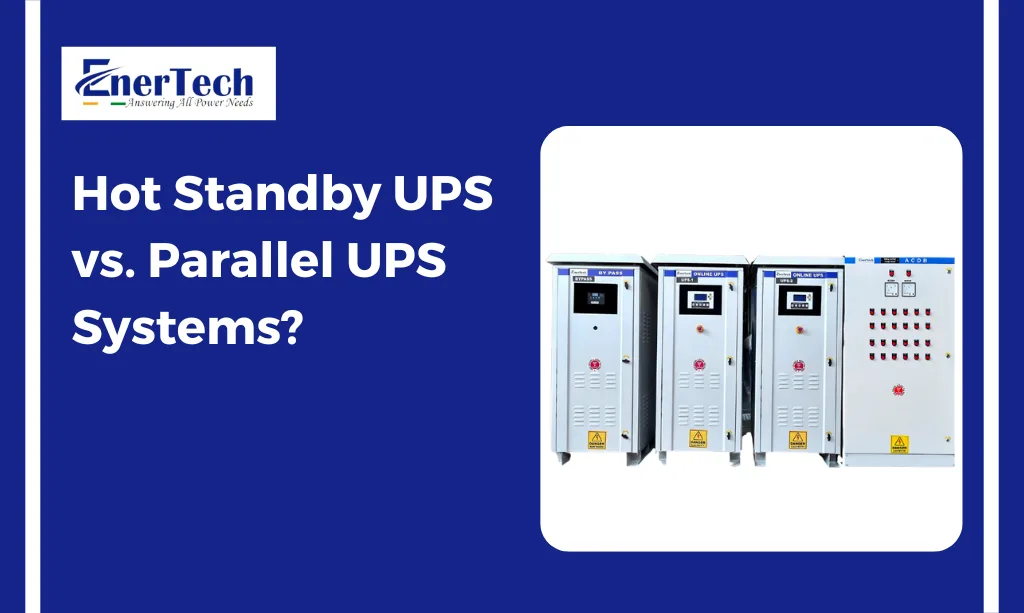While discussing seamless power supply and protecting critical systems from interruptions, we think of UPS – Uninterrupted Power Supply.
So, install a UPS and you are done! Simple, isn’t it?
However, here’s the kicker. UPS systems aren’t created equal. The market is full of different types of UPS systems, suiting various needs, circumstances, and objectives. Two popular choices among these include hot-standby UPS and parallel UPS systems.
Now, both these types are distinct. Hence, before you choose between them, you must know what makes them different to make an informed choice.
So, here’s a blog that precisely focuses on their differences. Learn
What is a Hot Standby UPS?
A hot standby UPS is a backup system that serves when the primary unit fails. It is like a substitute player who remains on standby but quickly replaces an injured one when the need be. A UPS setup has a primary UPS unit that actively supplies power and a second identical UPS that sits idle, yet fully powered to take over operations when its primary counterpart fails.
What is a Parallel UPS System?
Now, let’s understand what a parallel UPS system is. Imagine you are running a music concert and have multiple singers performing on the stage, sharing the vocal load. This closely resembles a parallel UPS system. It involves multiple UPS units working in unison to share the power load. Thus, if one unit fails, the remaining ones can blissfully pick up the slack, ensuring seamless power. It refers to collective strength and redundancy through a shared effort – team effort, if you may want to address it.
Hot Standby UPS vs Parallel UPS Systems – Key Differences
Both UPS systems aim to provide high availability, yet with distinct approaches that impact everything from cost to scalability. Let’s break down the key differences between both for a better comprehension and informed decision-making.
| Aspect | Hot Standby UPS | Parallel UPS System |
| Fundamental Operations | A primary active UPS and one or more secondary in standby mode for a quick and seamless switchover. | Multiple UPS units operate simultaneously to share the power load. |
| Redundancy | N+1 that provides redundancy against single-point failure of the active unit. | N+X that provides redundancy for multiple unit failures and allows for higher capacity. |
| Capacity | The primary unit has maximum capacity. The standby unit doesn’t have additional capacity beyond backup. | The system’s total capacity is the sum of the capacities of all units, ensuring greater power delivery. |
| Efficiency | The primary unit operates independently. Hence, it is potentially less efficient at lower loads. The standby unit consumes power even when it is idle. | Usually the system is more efficient, particularly at lower loads. It is because the load is distributed across different units, often operating at almost the peak efficiency. |
| Cost | Generally, the initial cost is lower for basic N+1 redundancy than a full parallel system of the same total capacity. | The initial cost is high due to multiple active units and a more sophisticated control circuitry. |
| Configuration and Management | Relatively easier to configure and manage. | More intricate control logic and power distribution is needed for load sharing and synchronization |
| Failover Time | The failover time is a few milliseconds. | The switch is almost instant. |
| Scalability | The scalability is limited. Typically, to add more capacity, you will have to replace the primary UPS or add a completely different hot standby pair. | The system is highly scalable. You can add additional UPS modules in parallel to increase both capacity and redundancy. |
When to Choose What?
So now, the next obvious question you may have is when you choose a hot standby UPS and when you would opt for a parallel UPS system. Let’s answer it precisely.
When to Choose a Hot Standby UPS?
- You have non-critical systems that can sustain brief failover times.
- You want redundancy with a limited budget.
- Your loads are smaller, for example – non-essential servers or office IT equipment.
- You prioritize maintenance simplicity and ease of installation.
When to Choose a Parallel UPS System?
- You need absolutely zero downtime.
- You run large-scale or mission-critical systems like hospitals or data centers.
- You need load sharing for efficiency.
- You want to avoid single points of failure.
- You are looking for a scalable system that aligns with your changing needs.
Need Top-Class Inverters for Your Application? Choose EnerTech!
Yes. EnerTech is one of the leading manufacturers of a range of highly efficient, and meticulously engineered inverters to serve diverse applications, including manufacturing setups, healthcare, and more. Our extensive inverter range offers technologically advanced features and functionalities that go beyond instant switchovers, and high availability. They help you tackle power interruptions and ensure continuous operations.
Want to know more about Solar Online UPS? or wanted to understand the difference between Online and Offline UPS? or explore our solar UPS and email us at sales@enertechups.com to connect with our experts and discuss your requirements in detail. We will be happy to serve you with a solution perfectly aligned with your needs.




